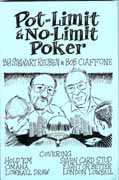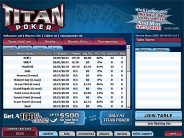
Pot-Limit and No-Limit Poker

Some No-Limit Hold'em Tournament Hands
Here are some hands that I played in Tunica at the World Poker Open in January 2005. They have been selected for this article because I played them in an unusual manner, rather than in my more usual, Bob Ciaffone is one of America’s best-known poker players, writers, and teachers. He has numerous poker tournament wins and placings, the most prominent being third place in the 1987 World Championship. He has been a poker teacher since 1995, with his students having earned well over a million dollars in tournament play. Bob's website is www.pokercoach.us straightforward style.
Bob Ciaffone is one of America’s best-known poker players, writers, and teachers. He has numerous poker tournament wins and placings, the most prominent being third place in the 1987 World Championship. He has been a poker teacher since 1995, with his students having earned well over a million dollars in tournament play. Bob's website is www.pokercoach.us straightforward style.
Before I discuss these hands, I would like to clarify what had happened in a Tunica hand that was discussed in one of my previous columns. My column said I was in the small blind, raised a pot preflop, and got called. Then it said I was checked to on the flop and moved in. It was graciously pointed out by a number of people that the small blind never gets checked to on the flop, because that person always acts first. In fact, I was on the button that hand. My apology.
I am a big believer in normally protecting my hand with a bet on the flop, instead of trying to be tricky. But look at how I decided to play this no-limit hold’em tournament hand. I had K-Q offsuit at a full table, with blinds of $25-$25. I started the hand with just over a grand in chips. The under-the-gun player called, I called, and three others behind me called. The small blind folded and the big blind rapped, so six of us saw the flop in a pot of $175. The flop came K J
J 8
8 , which was both good and bad news for me. The good news was, I had top pair with a good kicker, which is normally a betting hand. The bad news was, there were five other players in who may well have helped, either to a made hand or a draw, because three cards in or next to the top half of the deck were on the board. The big blind and the under-the-gun player both checked, and I had to decide what to do. There was no way I could take the heat if someone raised my flop bet, and I thought it too dangerous to bet, so I also checked. The next two players after me also checked, and the button bet $125. The big blind called, the under-the-gun player folded, and once again it was up to me.
, which was both good and bad news for me. The good news was, I had top pair with a good kicker, which is normally a betting hand. The bad news was, there were five other players in who may well have helped, either to a made hand or a draw, because three cards in or next to the top half of the deck were on the board. The big blind and the under-the-gun player both checked, and I had to decide what to do. There was no way I could take the heat if someone raised my flop bet, and I thought it too dangerous to bet, so I also checked. The next two players after me also checked, and the button bet $125. The big blind called, the under-the-gun player folded, and once again it was up to me.
Every time the betting comes to you, it is necessary to re-evaluate the situation in light of the extra info gained. The button was a young player who had been betting aggressively, and could have had a wide range of hands here. If I called, there would be $650 in the pot and I would have about $900 left. Despite the dangerous board, the betting indicated that I may well have the best hand. Accordingly, I went all in. To my relief, the button folded without much thought, and the big blind went into the think tank. I figured he had top pair with a worse kicker and would be in bad shape if he played. Maybe he would put me on a draw for the way I had played, so I was pulling for him to play. Finally, he flashed a king and folded. I flashed him a smile, but no cards, and took the pot. I think this hand shows that each new situation should bring about a rethinking of strategy, regardless of whether you agree with the way I actually played on this occasion.
Here is another hand in which I went against my usual custom and checked the flop. In a tournament when the blinds were at the $25-$50 level, I raised from under the gun to $150 with pocket jacks. I had one caller, the small blind, so there was $350 in the pot preflop. The flop came Q-6-3 rainbow, not the best, but playable. However, when my opponent checked, I also checked. Aside from simply trying to vary my play, here is what I was thinking: If I had the best hand, he would have only five outs or fewer. If an overcard came, that would scare him more than me, inasmuch as after I had raised from under the gun and checked, he would be afraid that I had A-K.
The turn was an offsuit 8, which looked like a complete blank. He checked again, so I figured him for a small pair and bet $300. He called. The river brought a black 4, another innocuous card. He checked, and I got piggish, betting $500 with what I believed to be the best hand. This is an example of what the poker expression “bet for value” means, trying to milk an extra bet instead of just showing down a moderate hand. My opponent went into deep thought, and finally bit, throwing his chips in for a call in a resigned manner. When I showed him my jacks, he nodded his head and folded. I always feel good when I am able to extract some milk from what looks like a dry cow.
This next hand illustrates a situation that I have run into several times lately. The blinds were $200-$400 with a $50 ante at a ninehanded table. There was a lady in the game who had run her chips up to about $10,000, but had suffered a series of reversals and was now down to only $3,400. She was a solid and experienced player, although a bit straightforward, and had missed some opportunities. On this hand, she was in the cutoff seat and I was in the big blind with the K 7
7 . Everyone folded to her and she called. The small blind also called, so there was now $1,650 in the pot, and it was up to me. I figured that if the lady did not have enough hand to bet her last 3 grand when everyone had folded to her, she would probably fold to a raise, so I popped it $3,000 more. She shrugged her shoulders and called with all of her chips; the small blind folded. We showed our hands, and she had two fives, the best hand, but only about a 53 percent favorite to win the pot, according to Poker Probe. It turns out that her fives stood up, so she got new life, and I had a serious derailment.
. Everyone folded to her and she called. The small blind also called, so there was now $1,650 in the pot, and it was up to me. I figured that if the lady did not have enough hand to bet her last 3 grand when everyone had folded to her, she would probably fold to a raise, so I popped it $3,000 more. She shrugged her shoulders and called with all of her chips; the small blind folded. We showed our hands, and she had two fives, the best hand, but only about a 53 percent favorite to win the pot, according to Poker Probe. It turns out that her fives stood up, so she got new life, and I had a serious derailment.
Do not let results obscure the truth of a situation. My preflop raise was fine, as she might not have been able to call, and I was getting sufficient pot odds on the actual hand when she did. Her play of limping in and then calling a raise was poor strategy. If she had gone all in preflop with 5-5, as she should have, she would have won the pot without a fight, rather than facing a serious chance of reporting to the rail.

